400,000 (and counting) men, women, and children adorned in pink pussy hats marched together in the most civil foot traffic New York City has probably seen in decades.
new york
Winter, New York
New York on a Canvas: Art by David Bransfield
New York City is not a place. It’s an experience. The buildings are high, apartments small, and streets overpopulated – but it never feels claustrophobic. Artists have tried to replicate its paradoxical beauty for as long as both the city and art have existed. And although the New York experience can’t be framed, artist David Bransfield has managed to bring his experiences of New York to life.
This interview has been edited and condensed.
Natalia Lehaf: How do you describe yourself as an artist?
David Bransfield: This is a totalizing question that is never easy for an artist to answer, especially because at this point in time I seem to be interested in many contrasting ideas and mediums. Overall, I would say that the common thread of my interests is the experiences and memories involved in the creation and immersion of a space. My previous work has spanned from ideas about geometry to urban landscapes to extremely conceptual depictions of surreal spaces, and I think that all of these ideas have a very specific relationship to the individual viewer.
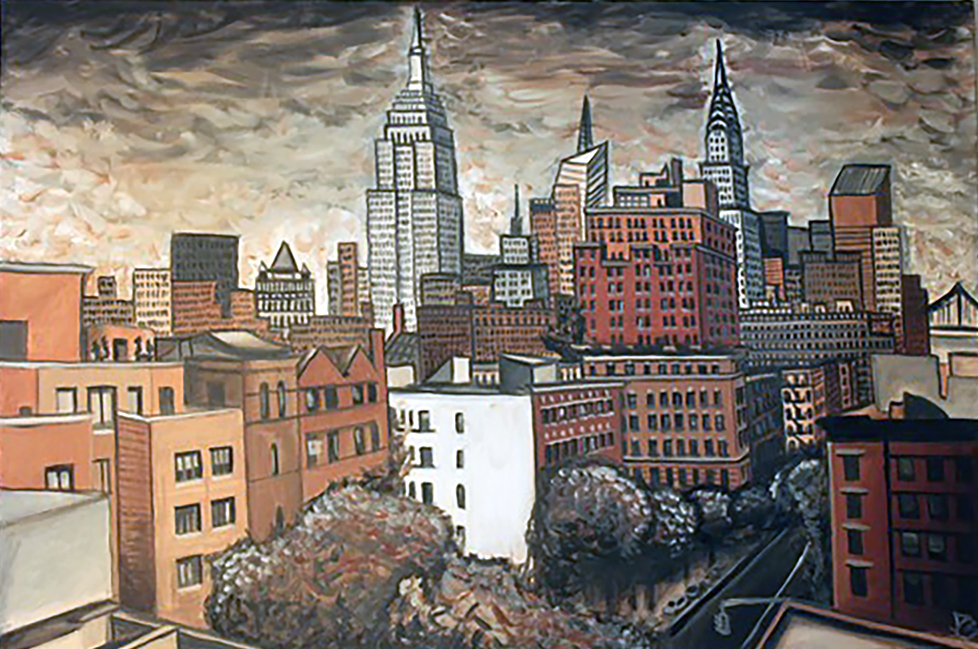
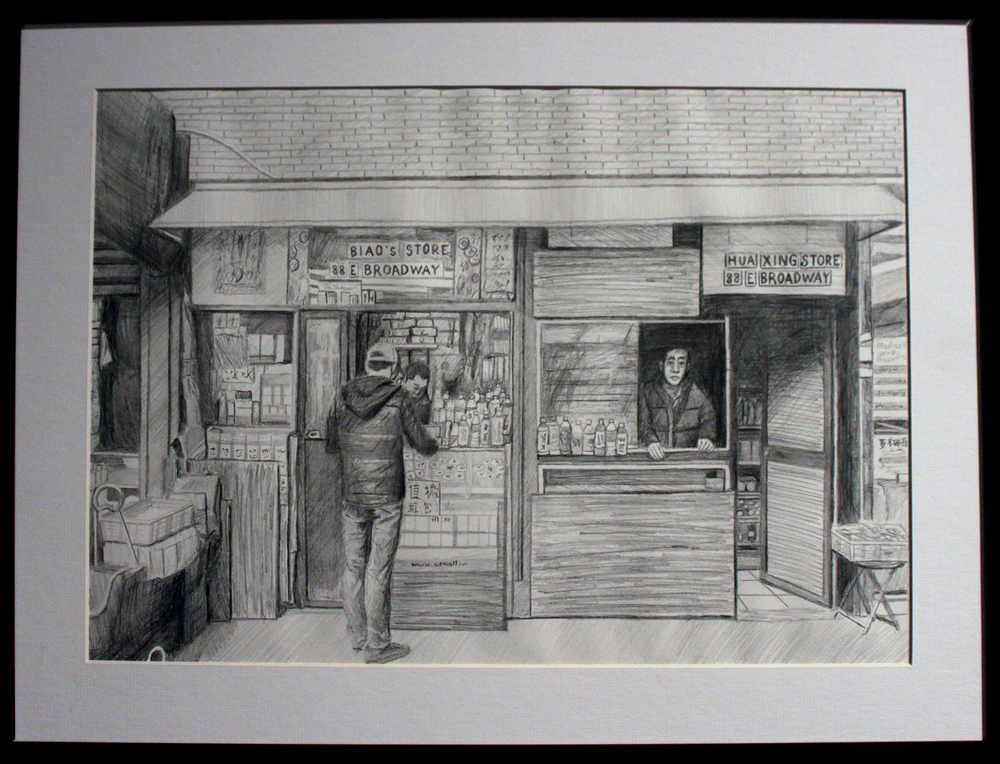
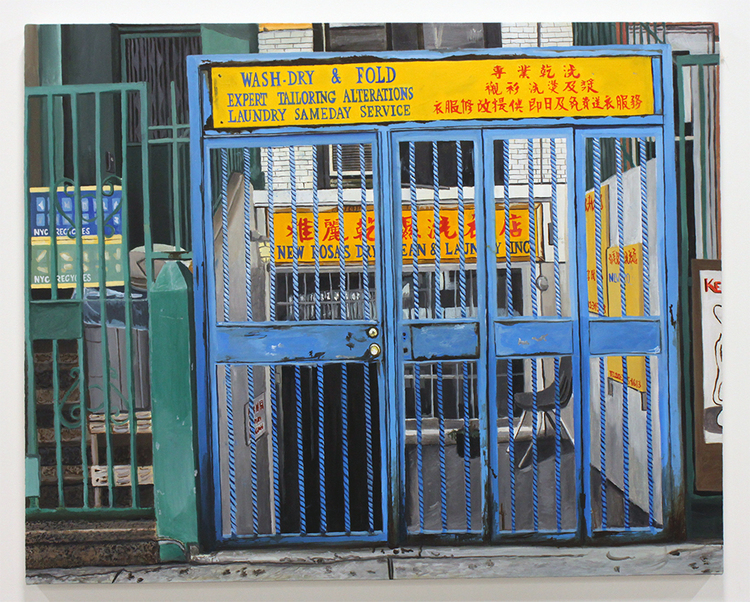
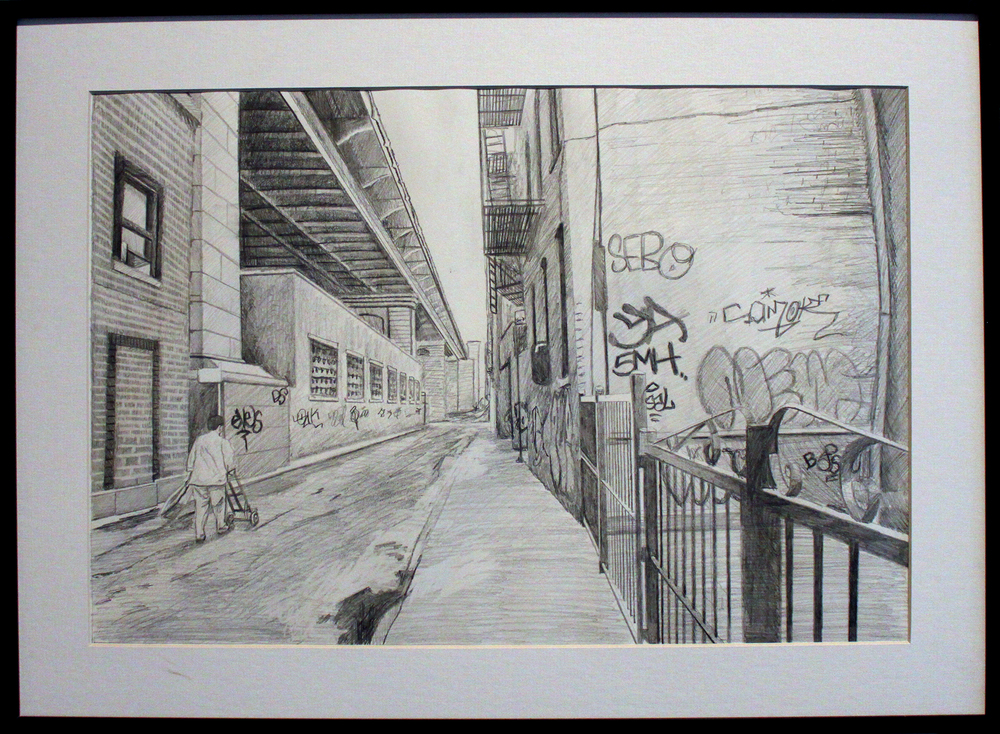

NL: What’s your background in art, both academically and personally?
DB: I have always been extremely curious as to how things are made, both from an artistic and architectural standpoint. My interests in both art and architecture turned into a career choice around 9th grade. I began attending an after-school art program on Long Island called the Huntington School of Fine Arts, where for the first time I was trained in the classical mediums of drawing, painting, and sculpting. I spent a couple years there and grew exponentially as an artist, and then from there I attended NYU as a double major in Studio Art and Urban Design & Architectural Studies.
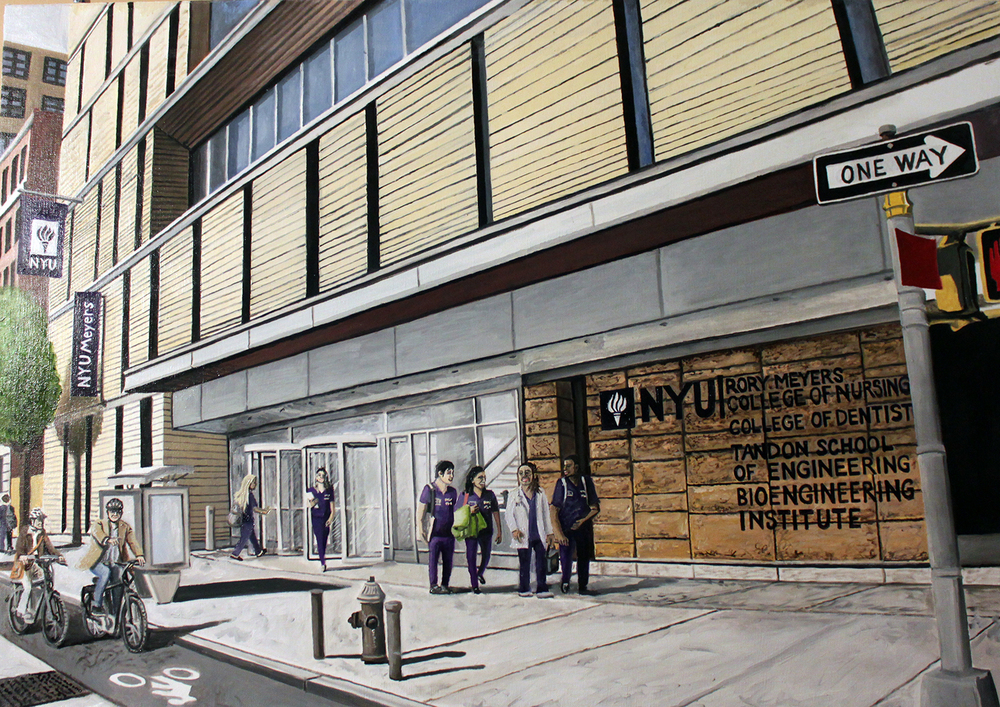
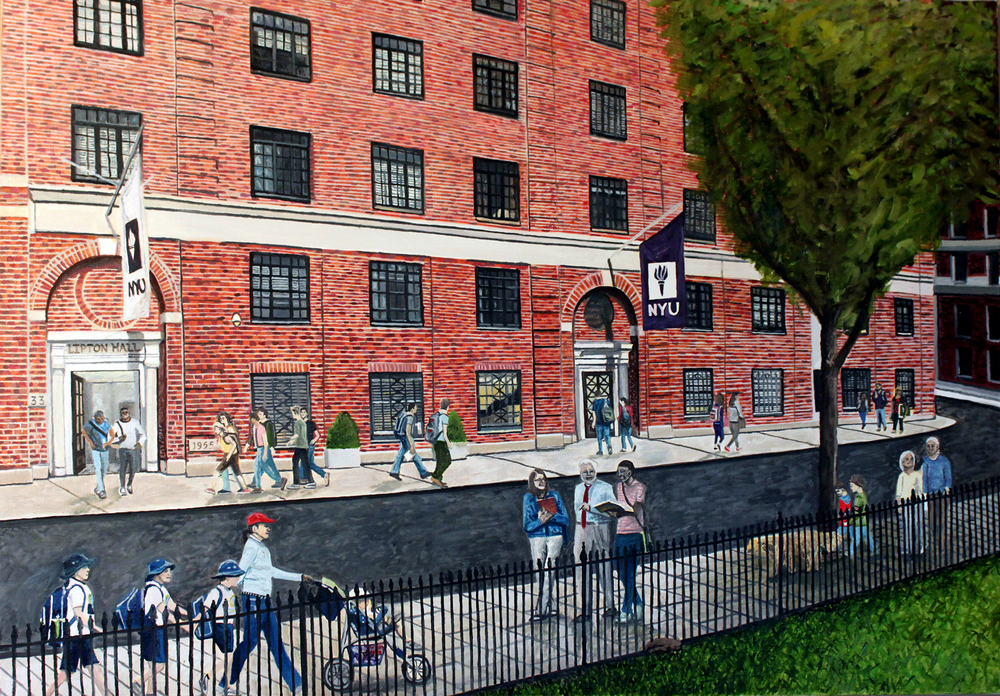
NL: Your sketches and paintings of New York City are very lifelike and precise. What is your relationship with the city?
DB: I grew up on the Queens/Long Island border only 20 minutes from Manhattan, so New York is my home. New York has always had an intense influence on how I think about art and architecture. Coming from such a rich and diverse place, I have always been interested in the makeup of communities as an insular composition of like-minded people, especially in New York where there are still many ethnic and religious-based communities. What interests me is how each of these communities come together to form a larger area that many people consider the “melting pot” that is NYC, yet there is still a definite division between neighborhoods, each with their own character and influence on each other. It is the dissection of “micro” versus “macro” in terms of the individual and the community that I have been trying to dissect in my more recent work. I am also extremely interested in this in terms of architecture and urban planning as well.
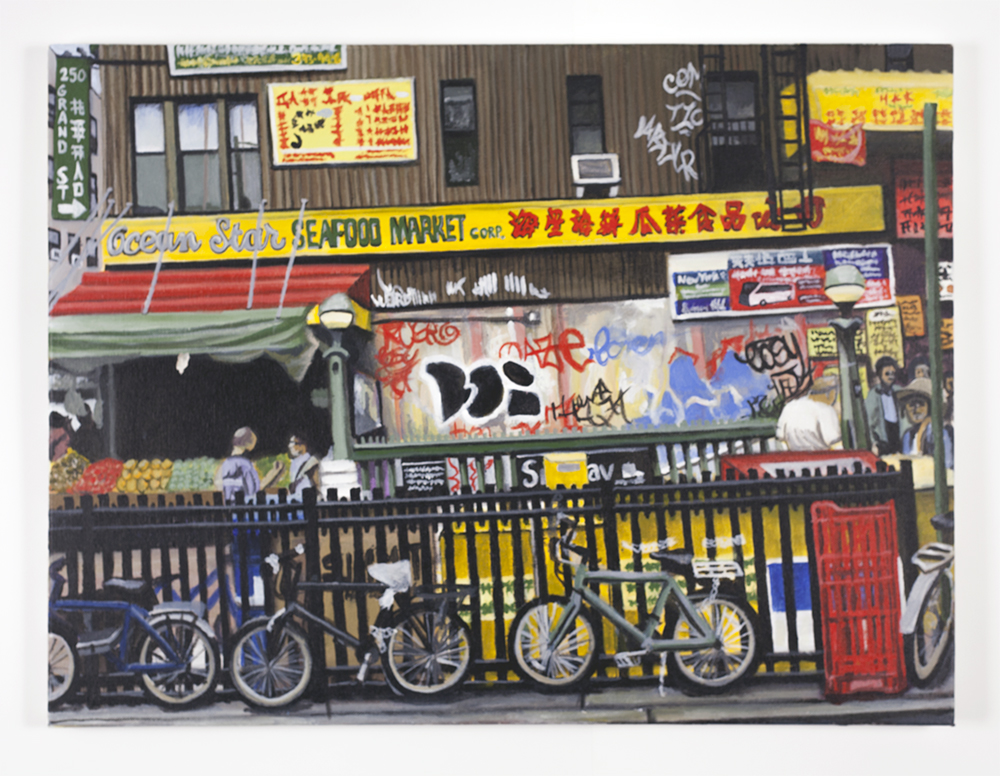
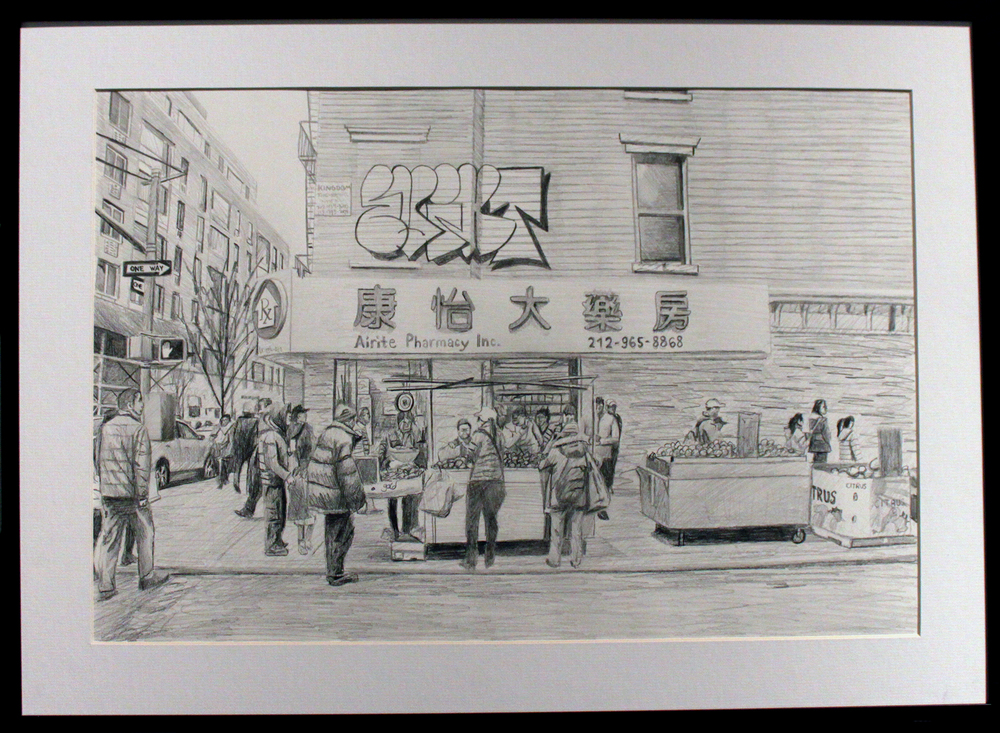


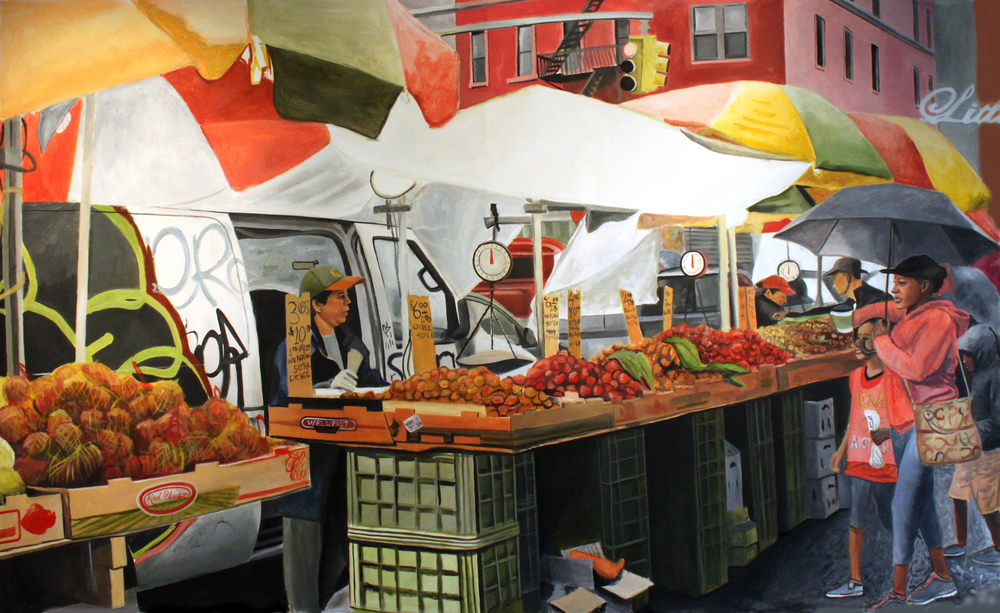
NL: What’s your process like?
DB: I’ll talk about the process for my most recent series of paintings, which were 6 to 10-foot urban landscape oil paintings. I began by assigning myself a large urban area to explore, which in this case was Chinatown. Then I wander. I find that wandering instead of trying to seek specific spaces can sometimes be more rewarding. If you have too specific of a goal, you will lose all sense of exploration in an attempt to find this goal and you may miss many unexpected opportunities. I had a set of guidelines to follow (finding spaces with rich color palettes, graffiti, and interesting people) but I let myself explore within these guidelines. For my first several wanderings I simply walk around and document spaces. I then go through my photographs and choose spaces which I believe have the most rewarding compositions and environments, and revisit these sites several more times for extended periods to capture a specific scene I wish to convey in my painting. After I decide on a composition which I believe makes for the best painting (this could be a single photograph or an agglomeration of several), I then make a series of sketches to resolve any compositional issues. This entire process generally lasts about 2 to 3 weeks before I begin the actual painting. The paintings themselves usually take about the same amount of time, and I try to stick with just one to two paintings at a time so I can focus on them without too many other distractions. I find that, personally, if I do not complete a piece within a reasonable amount of time or if I stop and revisit the piece later then it often turns out fragmented. Other than that, I do not focus too much on setting rules for myself while painting. I often find that the painting itself will dictate the rules of its creation, and I do not set these rules until I have already started painting. Stylistic rules will sort themselves out as the piece is being created. In terms of completion, I never feel like my paintings are truly finished. It is really just a matter of reaching a point where I am comfortable stopping, which I know is coming when I begin to get sick of the painting!

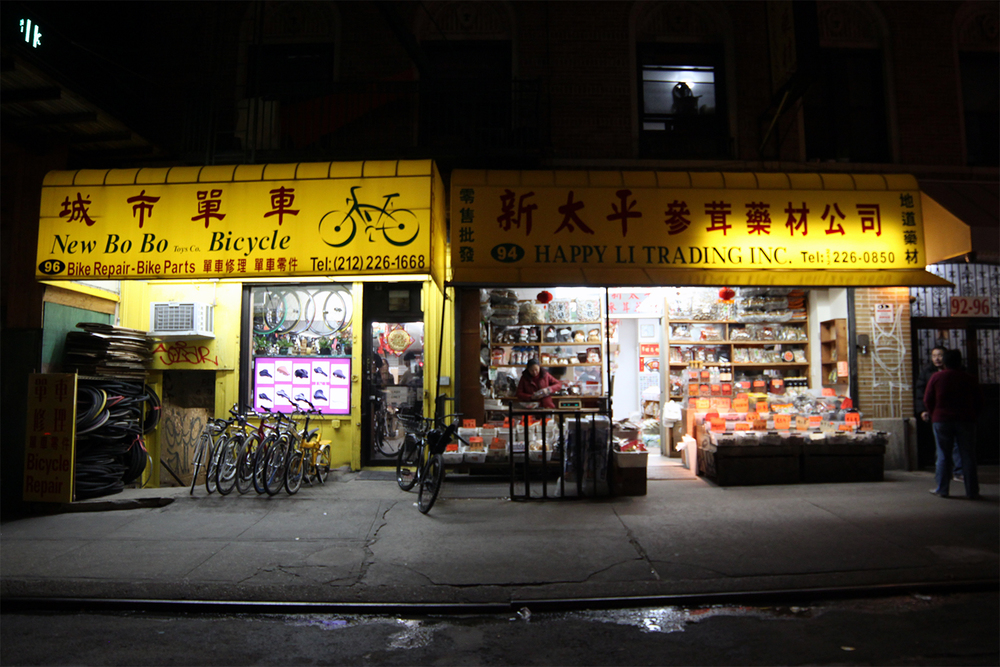






NL: You’re out of the city and studying architecture at Yale now. Are you continuing to paint and draw?
DB: I am still practicing art here, but I guess it depends on your definition of art. I am doing a lot of drawing (not as much painting because it is not as relative to the practice of architecture) but the drawings I am doing now serve more of a utilitarian purpose in that they are meant to convey the essence of my architectural projects. I would definitely argue that this is still an artistic form because there are infinite possibilities about how you convey your project, which will ultimately determine how the architecture is perceived. In this way it is almost just as important to have a strong representation of your building than to have a strong building itself. I am also learning to become extremely proficient with computer programs and to bring together multiple mediums in a single drawing which is exciting. I hope that after my time in architecture school I will be able to mix my skills and concepts learned from both art and architecture and find a truly intriguing and original artistic path for myself.
For more of David's work, check out his website.
The Rise and Shine of Amy Leon
Amy and I met at Friedman’s in Midtown West, both of us so insistent on eating chicken and waffles that we requested our waitress check again that the waffle machine was broken. We met just shortly after Amy’s audition for a play called The Death of the Last Black Man in the Whole Entire World by Suzan-Lori Parks. Amy was in a euphoric state–one that even a broken waffle machine couldn’t curtail.
This would be the case regardless of a great audition, I would later decide.
“The casting director had already bought tickets for my show in August,” Amy said in a naturally booming voice. (Her show at Joe’s Pub, two months after our lunch, was a sold out performance.) This blandishment did not grant Amy a sense of security that would silence her prayers about the role. “It’s such an important piece,” she explained. “I haven’t been acting since I graduated, and this is the first role that I’ve ever wanted. I was like, ‘Wow. I can go be black somewhere?’ It’s not about me–and it’s important. It was written in 1989, which is crazy, because there’s a whole section of it that’s like, ‘I can’t breathe. I can’t breathe. I can’t breathe. I can’t breathe.’ She wrote this twenty years ago and here we are talking about the same shit.”
In 2015, New York University asked Amy to perform at an event where Trayvon Martin’s mother would be speaking. As a gifted raconteuse, Amy felt a crucial obligation to say the right words–or more importantly, for Trayvon Martin’s mother to hear the right words. “Something that you see a lot when somebody dies–my mother just died in February–is people being very apologetic about your situation when they don’t know the full story. The situation demands pity. I don’t like pity.” She spoke with an élan that seized my motor skills and had me nodding along in consensus, deserting my ignorance of grief and its surrounding characteristics. It was not until a few months later, when I experienced a loss of my own, that I could understand.
“This is a testament of faith,” Amy continued. “The fact that this woman is going around the world and talking about her situation right after it happened. She woke up the very next day and had the same job; she didn’t win the lottery, nothing changed. She’s wearing the same clothes. She still has other kids. She still has to wake up everyday, sleep everyday, eat everyday. And suddenly everyone’s talking about her son, making t-shirts about her son, making fun of her son, making Halloween costumes out of her son. So what does she want to hear?” This wasn’t a question. She left no time for me to answer. “An identification of resilience.”
Amy performed her song “Burning in Birmingham” at the event. The song evokes the events of September 15, 1963 in Birmingham, Alabama, a day when members of the Ku Klux Klan planted dynamites beneath the front steps of 16th Street Baptist Church. Four girls died that day. “But there were five girls in the bathroom,” Amy said, voice still booming. “And Sarah Collins is alive today, under 70, still missing her right eye. She lost her sister and her best friends all at once. Didn’t even get to go to the funeral because she was at the hospital. She’s still paying medical bills today. And she’s watching this shit go down? How dare she have to watch this shit go down. How dare she have to pay for this. Nobody knows about her because she survived. The black woman has been surviving all this time and nobody’s looking at her, and she’s continuing to see all this shit.”
Amy’s pain was exacerbated by the negligible status of black women in the country, a matter she portrayed in the music video for “Burning in Birmingham.” She released the music video for it a few days before our meeting in June. “When it came to making the video, I knew I wanted black women because we are invisible–black women are last on the totem pole.” Her argument was simple: at least the death of black men is televised. “That’s why at the end of the video there’s a lot more bodies than those four little girls because the death is cyclical. It’s still happening. It’s still going. I don’t know when I am going to see a day when it’s not happening, but I am prepared to speak about it. And that’s why it doesn’t end on all the bodies–because I am not going to be crying forever, I am going to melt, breakdown, and then I am going to come back here and talk to you. And even if that’s the only time that I am healing, when I am talking to you about it, that’s what I am going to do.”
Amy spoke of the place black women have in society not as an emotional or moral burden, but as a token of their longanimity. Their skin is dark–but more importantly, it is thick. Racism exists, but still, so do they. Amy had been called a nigger three times in a week once; an experience she could never share with her mother. Her mother, white, Jewish, six-feet-tall, with blonde hair and blue eyes, would never experience someone rolling down their window and screaming that word at her before driving away. Their different exteriors created an internal divide. “I wrote this poem called Learning this Skin and it’s an analysis about how my mother will never be able to identify with me. At no point in her life will my mother walk down the street and be called nigger. And that’s my mother. That’s my blood. And she will never be able to identify with me as a black woman.”
I imagine this disconnect to be more of a venial offense, one that neither Amy nor her mother can help. Still, Amy’s relationship with her mother is complicated.
Amy grew up in the foster care system. She had lived in 13 different homes by the time she was 7 years old. Her mother would visit until she was 9, when she lost her visitation rights. Each visit, Amy’s mother searched her body for bruises, and subsequently pulled her out of homes with every discovery. “I had a lot of shit go down on me in my sleep. I’ve experienced every type of abuse there is,” Amy said. This abuse continued throughout Amy’s life, until she was 18 and matriculated at NYU.
At 13, she was adopted into an impoverished home by a 75 year old lady. There were other foster girls living there. Along with the girls were other inhabitants Amy described as “dangerous people.” These people abused the girls, a cycle many of them have been unable to escape.
“There’s a pattern of sexual abuse as if the world knows that that happened to you without you saying anything; it’s like an energy,” Amy said. “I’ve seen so many of the people I grew up with get taken advantage of and not know that they can change their minds or get taken out of these situations. For a lot of people, they can’t get out of these situations, because if you don’t have money and the person who is housing you and feeding you is also abusing you–then what are you expected to do? I’d rather be abused than be homeless sometimes. What’s worse? I don’t know.”
Amy did not tell anyone she was abused until the adoption was finalized. Despite feeling unsafe at home, Amy was going to school, she had friends, she planned to go to college–she didn’t want to risk these normalities for another home. “I lived with my abuser until I was 18. When I said something, [no one] believed me. He went to jail for touching another girl and then they let him out and let him stay in a home with foster children.”
And what of the social workers tasked to protect her and the other foster kids? “No one was checking in on us, nobody asking the right questions… I understand that keeping tabs on all of these foster kids in impoverished neighborhoods is difficult, but that's your job. They make these important jobs impossible to handle.”
Amy arranged to meet her mother once when she was at NYU to get baby pictures of herself. She had never seen pictures of herself as a baby before then. That same year, she received a Facebook message from a short Dominican man. The message read, “Soy tu padre.” That’s how Amy found out who her father was.
Amy had God: “I’ve experienced a lot of things in my world and time, and just knowing that there’s more than me has been incredible. God to me is the moon and then sunrise and the sunset, that consistency. No matter what happens, the moon will be there. The sun will rise. And the sun will set. I can’t even rely on myself to be consistent in anything, so to be able to see that everyday is like, ‘Yo, God has to exist ‘cause who’s doing that? Who’s pressing rewind?’”
Amy had poetry: “When I was in the 10th grade, I joined an acting company called MCC, and their whole thing was writing about your life and making your life into art. My first performance piece ever was through it. It was my autobiography in 1 minute. Afterwards, adults came to me and said, ‘Thank you for saying things I don’t know how to tell my children.’ I remember that day like it was nothing. These two women came up to me, gave me a hug, and broke down in my arms. I thought to myself, ‘Wow, I am still going home to this abuse but you just broke down in my arms and I’ve never done that before.’”
With these two counterparts, Amy had reason to celebrate the human existence. In this celebration, she is unapologetic and unfiltered. She talks about her shit, hoping that more people will do the same. And if they do, then she believes there would be a lot less shit in the world.
“If we could be more honest about all of our emotions and not just talk about joy–joy is amazing and happiness is incredible–but every single emotion is equal. If we paid the same amount of attention to the moments that bring us despair as the moments that bring us joy, then we remember so much more. You know when someone’s not really smiling–it’s scary that we can see that in each other, but refuse to acknowledge it.”
I sat across from Amy, stunned. Learning about her life made me unconsciously compare our narratives, wondering why the same God gave me my sheltered existence.
But, I knew what she meant–sensing sadness in others, surmising that something isn’t right, and choosing to ignore it. It always seemed easier that way.
I commented on this wisdom and bravery, referencing her past and alluding to her future–but before I could finish, she stopped me. “You’ve been through some shit, girl, it wasn’t the same, but you’ve been through some shit, too. I’ve been sad and you’ve been sad, we’ve both been sad. I don’t think there’s a range. And I don’t think I work harder than anybody, I think I am living my life and everybody else is living their lives. I try to emphasize to the kids I teach [at art workshops]: you are not your situation. Your situation does not need to define you. My environment didn’t stop me from living my life. The difference is just knowing that. Everyone can take the train from 110th street to 42nd street, everyone can do that. There are people I know who’ve never left the block, who’ve had four generations of their family in that one place; and while that’s amazing, I was just like: ‘When I was 16 I went to Paris and I found out that people look different, I wish you knew!’”
Last year, Amy got sick. She told me about her chronic migraine disorder, how it causes her to pass out and have seizure-like and stroke-like symptoms every single day. She’d seen seven neurologists in the past year. None of them had any clue what was wrong with her, where her problems began and where they ended. She had performed with this condition, and managed to continue performing while having seizures on stage.
At one point, she had to quit: performing and teaching, for fear of passing out on stage or in front of her students. When she wasn’t performing, she’d go to her roof and watch the sunset. The consistency of the sun coming and going, clockwork in the sky, was her obsession, her piece of God.
Amy had published two books when me met, and was about to start touring shortly after. She’d coordinated the tour entirely by herself, using Twitter to reach out to venues that follow other artists.
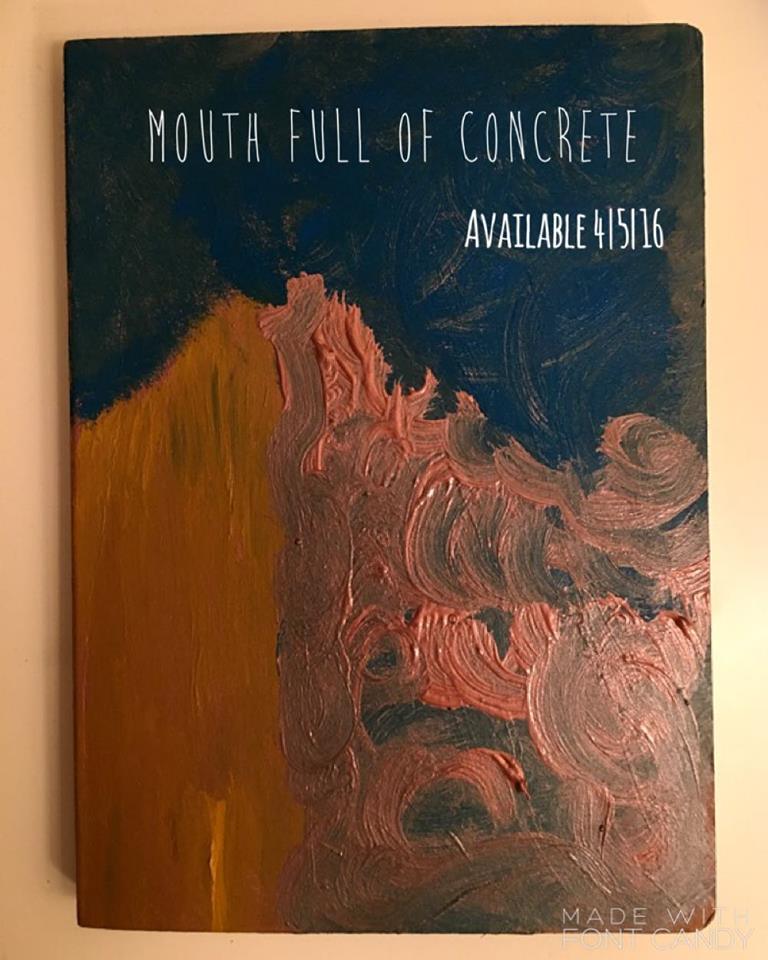

She’d been writing every day, for upcoming shows and a third book. She stressed that she doesn’t like submitting anything because she refuses to edit her work. “I will not edit my work. You are going to take it the way I want it. Absolutely not. I have no time. You can give me a suggestion, but I am not going to edit anything. A lot of people allow themselves to lose their spirit when things are edited, and I don’t do that.”
I asked her what exhausts her.
“The work. It’s really heavy. I feel everything so much. I become a sponge when good and bad things happen. It exhausts me but is also the most exciting part of my life. I want to speak to everyone after a show, but I need five minutes because I just threw up–literally–on stage.”
I couldn’t help but clarify. Do you really throw up?
“No. My experience on stage is a blackout experience. I don't really know what happens,” she said, before adding, “I feel so fortunate, I just started seeing words to music. You know synesthesia? Seeing colors? I did improv a few weeks ago and I felt like I was reading the air. I saw words in the air.”
Amy was flushed with excitement when we met. The prospect of acting in a production with words as profound and familiar as her own autobiographical work thrilled her. “If I die and no one has ever seen me anywhere in more than a 200 person venue, I don’t give a fuck, because it was permanent in your life. It was permanent in mine. That’s all I need. Thank you for letting me make things permanent for myself as an artist. You can’t tell me that I don’t exist if I am right here. And that’s why I need this part in this play! In it, there’s a character that keeps saying:
‘You should write this down. You should put it under a rock. Because when they find the piece of paper that you wrote it on, they can say it didn’t exist. But if you put it under a rock, they can’t say the rock didn’t exist. That’s nature.’”
Amy’s words, performances, and influence have an everlasting quality that bodies don’t. I realized that Amy’s reliance on the sun–its comings and goings–was a reflection of her. Amy was a beam of light. She fights the darkness of social inequality with honesty, faith, and love. Her egalitarian convictions are melodized in her performances. But she claims the base of her work is something else: “As artists, we are trying to recreate the colors of the sky changing–whether it’s in poetry, music, dance, or paint.”
Amy’s always looking up to the sky, her God, and reflecting it back down to us.
Amy's album, Something Melancholy, will be available on November 15. A release party for the album will take place at C'mon Everybody in Brooklyn the same day at 8pm. For more information about Amy and her work, check out her website.
Three Poems
Saying Goodbye Chelsea
Chelsea Window #1
August 2014
Windows focus our view onto an image, perhaps different when our line of vision is changed, but a single image nonetheless. Does perspective matter if you’re only being presented with the same glass guarded picture again and again? Yes. Looking down 23rd street here, I focus on a memory. What I see in her is very direct, and almost toy-like. I can tinker with this view. I can focus on the black car, and be sad; focus on the red awning and be mad; or focus on the nothingness surrounding what’s focused. I choose to ignore what is apparent. I take this picture while in a comfortable relationship for 3 years from the 21st floor of the apartment building I live in.
Chelsea Window #2
June 2015
Windows constrict our views - sometimes onto a grey image where there is no escaping that bleak outlook. It’s hard to see anything but what is right in front of you, and looking away to the black outreaches only seems more hopeless. I’m focused but also trapped. I’m depressed in my apartment on the 21st floor, and Chelsea looks ugly--vicious even. The only option is to remain in this box and hope my perspective changes soon. This window is less of a lens, and more of a cage. I take this picture as a depressed and single 21-year-old, a month away from what would have been 4 years in a relationship.
Chelsea Window #3
June 2015
Windows magnify our views on the everyday world around us. Chelsea takes me by surprise this afternoon. The monotonous blue skies and humid weight of the skyline are greeted by a purple sunset that caresses the tops of buildings. For the first time in weeks, the window on the 21st floor seems like it’s inviting me to see a bigger picture. There’s freedom and hope in this skyline. She had tricked me earlier—life isn’t the dark box it seemed to be before. There is a reason to look up, and no reason to look down. I take this picture a couple weeks after the last, healing slowly.
Chelsea Window #4
January 2015
Windows don't matter at all. Our view is strictly what we want to see, no glass can distort or control that. If I want to see something, then that’s where I’ll look. Windows are clear for a reason - so we, as humans, can see whatever we want, at all times. The 21st floor allows me to see everything in The City—in her—but I choose to simplify that view. What matters is the emotion; the shapes I have lost and the colors I have gained. Maybe the window is trying to protect me from what’s on the other side, but I need to feel that visceral pain to grow. And I have felt it. I took this picture at the peak of my relationship, but now looking back, it foreshadowed something both ominous and beautiful that was going to occur. The biggest loss and gain in my life to date.
Chelsea Window 0
G-O-D-E-S-S
You were the best.
G-O-D-E-S-S
I needed your sex.
Focused and lost,
I was in pain
Whenever
You were out of
Frame.
Like a sunset,
The beauty
Only hides the ugly.
You’re so ugly.
Tennessee Nunez is a 21 year old rapper and photographer based in NYC, currently studying at Hunter College. Find him on Instagram and Soundcloud.





